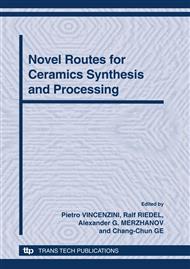p.30
p.36
p.41
p.47
p.52
p.58
p.62
p.68
p.74
Microwave Assisted Solvothermal Synthesis and Visible Light Photocatalytic Properties of Nb and N Co-Doped SrTiO3 Nanoparticles
Abstract:
Niobium and nitrogen co-doped SrTiO3 possessing excellent visible light responsive photocatalytic activity was successfully synthesized by microwave-assisted solvothermal reaction using SrCl2.6H2O, Ti(OC3H7)4, NbCl5 and hexamethylenetetramine in KOH aqueous solution. The photocatalytic activity was determined by DeNOx ability using LED lamps with the wavelengths of 627 nm (red), 530 nm (green), 445 nm (blue) and 390 nm (UV). The photocatalytic activity of SrTiO3 for DeNOx ability in visible light region could be improved by co-doping Nb5+ and N3-. The excellent visible light photocatalytic activity of this substance may be due to the generation of a new band gap that enables to absorb visible light and decrease in the lattice defects which acts as a recombination center of photoinduced electrons and holes.
Info:
Periodical:
Pages:
52-57
Citation:
Online since:
October 2010
Authors:
Price:
Сopyright:
© 2010 Trans Tech Publications Ltd. All Rights Reserved
Share:
Citation:


